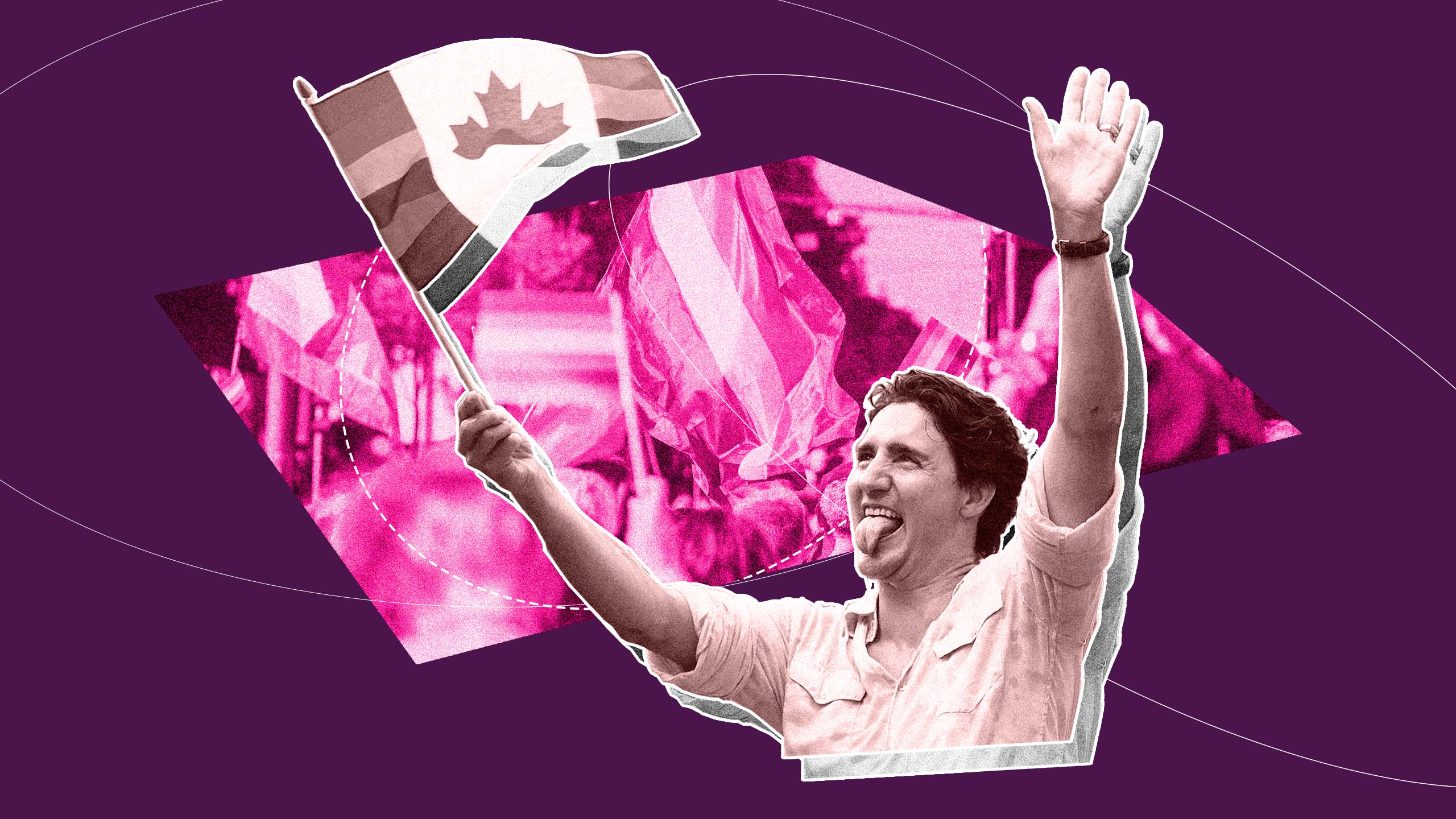When a few dozen folks gathered in Vancouver’s Stanley Park in 1981 for the city’s first official Pride parade, several people wore paper bags over their heads.
“It was both a symbol of the challenges faced by gay people and because some people just didn’t want to be identified,” Svend Robinson, Canada’s first openly gay member of Parliament, tells Xtra. Though not out himself at the time, he felt—as an elected representative of the local area— that it was important to attend and support the LGBTQ2S+ community. Yet he recalls being an outlier at the time. “There was virtually no media coverage, and politicians wouldn’t come anywhere near Pride parades for a very long time.”
That’s a far cry from the frenzied media coverage, decades later, around major Canadian political leaders participating in Prides, culminating in Prime Minister Justin Trudeau’s 2016 presence at Toronto Pride, donning the much-discussed pink button-up and making history as the nation’s first prime minister to walk in Pride. Goodbye paper bags.
But the dynamic between politicians and Prides has begun to shift once again. Last month, Pride P.E.I. uninvited all political parties following frustrations about the province’s Progressive Conservative leader and his failure to defend the community in a recorded conversation with a transphobic constituent.
Pride P.E.I.’s decision echoes similar sentiments from recent years. In 2020, Vancouver Pride banned British Columbia Liberals after they failed to discipline caucus members who were using taxpayer dollars to buy ads in an anti-LGBTQ2S+ publication. Last year, Calgary Pride wouldn’t grant the United Conservative Party access after they failed to meet their criteria for supporting the community, and Winnipeg Pride blackballed Manitoba premier Heather Stefanson after she committed to speak at and walk in the festival’s parade—only to duck out for another event shortly before.
Prides in every region of the country, and the queer and trans people who organize them, are increasingly asking the question: do we even want politicians here?
The beginning of politicians and Prides
While queer and trans people have been gathering to celebrate and uplift each other much longer than the past half century, most of the country’s Pride celebrations—in the way we’d recognize them today—began in the 1970s and ’80s.
At those gatherings, politicians weren’t just not invited. They were, in many cases, the target.
“When we first initiated the Toronto Pride committee in 1981, in the context of the bath raids, it was certainly not within our thoughts that we’d want politicians to be attending,” says Gary Kinsman, a queer historian and longtime activist. “We were in resistance against the police and political establishment.”
Kinsman explains that queer and trans people across the country used Prides as an organizing force to either achieve a specific objective—such as to repeal the bawdy house laws enforced at the aforementioned bathhouse raids, and drop all related charges—or to garner more general support for LGBTQ2S+ people from governments, typically in the form of officially recognized days, weeks or months for Pride.
But Pride’s protest-oriented origins didn’t preclude politicians from participating. After all, leaders jockeying for public office often use protest movements to deepen their experience with community engagement. For Prides, though, other factors weighed too heavily on politicians.
“We were living through this incredibly terrible and painful pandemic of HIV/AIDS, and the homophobia around HIV/AIDS was devastating,” says Robinson, who, after coming out publicly in 1988, started touring Prides across the country. “A lot of politicians steered clear of anything that would in any way associate them with the gay community because of the stigma of HIV/AIDS.”
This is echoed by Libby Davies, Canada’s first openly lesbian member of Parliament. “There was fear about being seen with all these gays, fear of identification—are people going to think I’m one of them?” says Davies, who also attended Prides before publicly coming out during a 2001 parliamentary session. “For other politicians, it was just not considered a place to be. You weren’t going to get anything out of it.”
How politicians warmed to Pride
By the early 1990s, Prides became more popular and the committees behind them began to alter their focus—especially when it came to money.
“Prides started to be very concerned with getting corporate donations and government funding,” says Kinsman. “And as Pride committees get more and more tied into state funding, they have tended to move in the direction of having the politicians there, regardless of their politics or how supportive they are of us.”
That’s not to say there wasn’t resistance to this from specific groups within the community at the time—but as the scale of Prides grew, so too did the desire to meet that growth with bigger entertainment, better branding, more security and grander fundraising. For better or worse, the corporatization of Prides cleared a path for politicians to follow.
“There was a big shift when the Royal Bank started showing up to Pride,” says Davies. “With big sponsors and all the banks already there, then you’d see the leaders of political parties start attending.”
Whether the participation of corporations made Pride more palatable or companies were simply first to act on changing sentiments around queer people, the result was the same: there were suddenly real organizing and media opportunities around Pride, and politicians recognized that.
“Politicians would use Prides to legitimize themselves and build their political support—and Prides were going out of their way to invite them,” says Kinsman.
A transactional or symbiotic relationship?
Whatever the intentions behind a friendlier rapport are, the majority of today’s Prides continue to enjoy an amicable relationship with politicians—despite harder-lined stances taken by P.E.I. Pride and aforementioned others. For this story, Xtra polled more than two dozen Pride organizations from every province and territory in Canada about their policies re: politicians. The majority of responses strike an apolitical, amicable tone—with Pride committees expressing a desire to see politicians do more to support queer and trans people, but also welcoming their continued presence and participation.
Whether or not this is motivated by funding is unclear, and will differ between each Pride and committee behind it. But there is real value in continued engagement with politicians in Pride, say some. First, as a barometer of alliance.
“It’s much easier to see who supports us as a community and who doesn’t,” says Curtis Atkins, co-founder and deputy executive director of ProudPolitics, an organization dedicated to getting more LGBTQ2S+ people into elected office. “When it comes to political parties, it’s often the absence of a party that really puts it in the spotlight.”
Atkins points out that removing partisanship from Pride risks disengaging the community from voting, which we can’t afford to do. “Politics never ignores queer people, whether for good or bad—and that’s why we can’t afford to ignore politics.”
This is especially the case now, as tensions rise between an increasingly mobilized far-right movement in Canada and queer and trans people.
“It’s really important our politicians realize that the gains we have made are being eroded very fast—they’re being attacked,” Pride Toronto’s executive director Sherwin Modeste tells Xtra. “If they want to come and march and protest and celebrate with us, they have to do so in solidarity.”
Modeste and Pride Toronto are particularly concerned about safety in this summer’s festival following a growing number of clashes around drag queen performances and other queer events. Rather than shut politicians out, Pride Toronto is meeting with federal and provincial ministers to discuss how they’ll help keep the peace and protect queer and trans people at this year’s event.
“Pride Toronto is not going to be part of the photo op with politicians if they’re not committed to ensuring that LGBTQ2s+ communities are safe.”
Pride as an opportunity for politicians
Whatever a Pride’s position on partisanship is, politicians should use Pride as an opportunity not to raise their own name recognition or demonstrate blanket support, but rather to pause, listen and reflect on what they’re hearing from people at Prides.
“A Pride parade is a very fun thing, but it also means you have a lot of interactions with people,” says Davies. “Maybe some of those interactions are uncomfortable, but they—at a literal street level—can really leave an impression on you.”
This is particularly relevant in relation to trans and non-binary people who are facing the brunt of hate directed toward the community right now, says Robinson. “Listen to your constituents—to trans people in your community, to parents of trans kids who are being attacked today. Take your direction from them.”


 Why you can trust Xtra
Why you can trust Xtra


